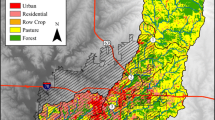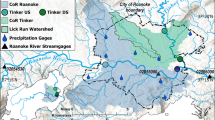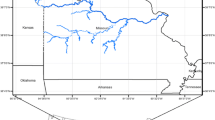Abstract
Several stream monitoring programs aim to measure nonpoint source pollutant loading to the major river systems in the Twin Cities Metropolitan Area (TCMA) of Minneapolis and St. Paul, Minnesota. However, due to cost and logistical considerations, only a portion of the total nonpoint source load can be effectively monitored. Regression models were developed relating nonpoint source pollutant yields to landscape characteristics in order to estimate the total nonpoint source contributions of nutrients and suspended sediments to the Mississippi, Minnesota, and St. Croix Rivers from the region. The regression models were generally strong with r-squared values ranging from 0.57 for total suspended solids yield to 0.90 for nitrate yield. The model factors included both land cover variables, such as the percent row crop or the percent urban land as well as soil variables, such as the percent organic matter or the percent clay. These results highlight the importance of considering both land cover and soils when estimating nonpoint source pollutant loads. Using the fitted regression models, the estimated annual average total suspended solids, total phosphorus, nitrate, and total Kjeldahl nitrogen loads for the TCMA are 104,000 metric t/yr, 354 t/yr, 3,580 t/yr, and 1,760 t/yr, respectively.
Similar content being viewed by others
References
Birr, A. S. and Mulla, D. J.: 2002, ‘Relationship between lake and groundwater quality patterns and Minnesota agroecoregions’, Hydrological Sci. Tech. 18(1–4), 31–41.
Chow, V. T., Maidment, D. R. and Mays, L. W.: 1988, Applied Hydrology. McGraw-Hill Book Company. New York, NY. pp. 572.
Cohn, T. A., Delong, L. L., Gilroy, E. J., Hirsch, R. M. and Wells, D. K.: 1989, ‘Estimating constituent loads’. Water Res. Research. 25(5): 937–942.
Driscoll, E. D.: 1986, ‘Detention and retention controls for urban runoff’, in B. Urbonas and L. A. Roesner (eds), Urban Runoff Quality — Impact and Quality Enhancement, ASCE. pp. 381–393.
Driver, N. E. and Tasker, G. D.: 1988, ‘Techniques for Estimation of Storm-Runoff Loads, Volumes, and Selected Constituent Concentrations in Urban Watersheds in the United States. U.S. Geological Survey’, Water Supply Paper 2363. pp. 51.
EPA: 1983, Results of the Nationwide Urban Runoff Program: Volume 1 – Final Report. United States Environmental Protection Agency, Office of Water. Washington, DC. (EPA-832-R-83-112). pp. 200.
EPA: 2000, Progress in Water Quality, ‘An Evaluation of the National Investment in Municipal Wastewater Treatment’: Chapter 12 – Upper Mississippi River Case Study. United States Environmental Protection Agency, Office of Water. Washington, DC. (EPA-832-R-00-008). pp. 34.
EPA: 2002, National Water Quality Inventory: 2000 Report. United States Environmental Protection Agency, Office of Water. Washington, DC. (EPA-841-R-02-001). pp. 207.
Huber, W. C. and Dickinson, R. E.: 1988, Storm Water Management Model Version 4 User's Manual. United States Environmental Protection Agency, Athens, GA. (EPA/600/3-88/001a). pp. 595.
Jones, K. B., Neale, A. C., Nash, M. S., Van Remortel, R. D., Wickham, J. D., Riitters, R. H. and O'Neill, R. V.: 2001, ‘Predicting nutrient and sediment loadings to streams from landscape metrics’: A multiple watershed study from the United States Mid-Atlantic Region’, Landscape Ecology, 16(4): 301–312.
Langland, M. J., Edwards, R. E. and Darrell, L. C.: 1998, Status Yields and Trends of Nutrient and Sediment Data and Methods of Analysis for the Non-Tidal Data Collection Programs. Chesapeake Bay Drainage Basin: 1985–1996. U.S. Geological Survey, Baltimore, MD. Open File Report 98–17. pp. 67.
Lenz, B. N., Robertson, D. M., Fallon, J. D. and Ferrin, R.: 2003, Concentrations and Loads, and Benthic Invertebrate Data for Tributaries to the St. Croix River, Wisconsin and Minnesota, 1997–99. U.S. Geological Survey. Water Resources Investigation Report 01-4162. pp. 70.
Loehr, R. C.: 1974, ‘Characteristics and comparative magnitude of non-point sources’, J Water Poll. Control Fed. 46(8). 1849–1872.
Metropolitan Council: 2003, Quality Assurance Program Plan: Stream Monitoring. Metropolitan Council, Environmental Services Division. St. Paul, MN. pp. 28.
Metropolitan Council: 2004, 2002 Stream Monitoring and Assessment for 11 Metropolitan Area Streams. Metropolitan Council, Environmental Services Division. St. Paul, MN. pp. 171.
Metropolitan Council: 2005, 2003 Stream Monitoring Report. Metropolitan Council, Environmental Services Division. St. Paul, MN. pp. 288.
Mulcahy, J. P.: 1990, Phosphorus Export in the Twin Cities Metropolitan Area. Metropolitan Council,. St. Paul, MN. pp. 26.
Omernik, J. M.: 1987, ‘Ecoregions of the conterminous United States’, Ann. Assoc. Am. Geog. 77(1), 118–125.
Robertson, D. M. and Saad, D. A.: 1996, Water Quality Assessment of the Western Lake Michigan Drainages — Analysis of Available Information on Nutrients and Suspended Sediment, Water Years 1971–1990. U.S. Geological Survey Water-Resources Investigations Report 96–4012. pp. 167.
Walker, W. W.: 1996, Simplified Procedures for Eutrophication Assessment and Prediction: User Manual. U.S. Army Corp of Engineers, Waterways Experiment Station, Vicksburg, MS. Instruction Report W-96-2. pp. 238.
Warwick, J. J. and Tadepalli, P.: 1991, ‘Efficacy of SWMM Application’, J. Water Resour. Plng. and Mgmt. 117(3), 352–366.
Wenck Associates, Inc: 2004, ‘Shingle Creek and West Mississippi Watershed Management Commissions’: Annual Water Quality Report 2003. Maple Plain, MN. pp. 36.
Wright, H. E., Jr.: 1972, ‘Physiography of Minnesota, in Sims, P. K., and Morey, G. B., (eds), Geology of Minnesota’: A Centennial Volume. Minnesota Geological Survey. pp. 561–578.
Yuan, F., Sawaya, K. E., Loeffelholz, B. C. and Bauer, M. E.: 2005, ‘Landcover classification and change analysis of the Twin Cities (Minnesota) Metropolitan Area by multitemporal Landsat remote sensing’, Remote Sens. Environ. 98 (2-3), 317-326.
Zapp, M. L. and Almendinger, J. E.: 2001, Nutrient Dynamics and Water Quality of Valley Creek, a High-Quality Trout Stream in Southeastern Washington County, Final Project Report to the Valley Branch Watershed District. St. Croix Watershed Research Station, Marine on St. Croix, MN. pp. 31.
Author information
Authors and Affiliations
Corresponding author
Rights and permissions
About this article
Cite this article
Kloiber, S.M. Estimating Nonpoint Source Pollution for the Twin Cities Metropolitan Area Using Landscape Variables. Water Air Soil Pollut 172, 313–335 (2006). https://doi.org/10.1007/s11270-006-9083-4
Received:
Accepted:
Published:
Issue Date:
DOI: https://doi.org/10.1007/s11270-006-9083-4




